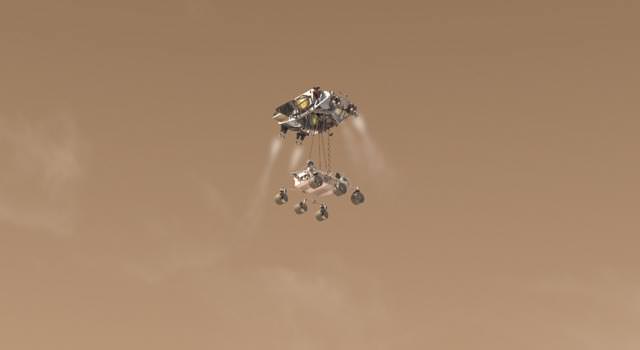[/caption]
Mission planners have narrowed the field for possible launch dates for NASA’s next generation rover to Mars, the Mars Science Laboratory, nicknamed Curiosity. Taking into account orbital mechanics, planetary alignment, and communications issues, MSL’s launch will occur between Nov. 25 and Dec. 18, 2011, with landing will taking place between Aug. 6 and Aug. 20, 2012. The actual landing site is still being decided, between four different locations on Mars (read about the four sites here.)
“The key factor was a choice between different strategies for sending communications during the critical moments before and during touchdown,” said Michael Watkins, mission manager at NASA’s Jet Propulsion Laboratory in Pasadena, Calif. “The shorter trajectory is optimal for keeping both orbiters in view of Curiosity all the way to touchdown on the surface of Mars. The longer trajectory allows direct communication to Earth all the way to touchdown.”
Landing on Mars is always very difficult, and NASA has put a high priority on communication during Mars landings, especially after a landing failure in 1999. Therefore, the flight schedule allows for favorable positions for the Mars Odyssey and the Mars Reconnaissance Orbiter, currently orbiting Mars, which can both obtain information during descent and landing of MSL.
The simplicity of direct-to-Earth communication from Curiosity during landing has appeal to mission planners, but the direct-to-Earth option allows a communication rate equivalent to only about 1 bit per second, while the relay option allows about 8,000 bits or more per second.
“It is important to capture high-quality telemetry to allow us to learn what happens during the entry, descent and landing, which is arguably the most challenging part of the mission,” said Fuk Li, manager of NASA’s Mars Exploration Program at JPL. “The trajectory we have selected maximizes the amount of information we will learn to mitigate any problems.”
Curiosity will use several innovations during entry, descent and landing in order to hit a relatively small target area on the surface and set down a rover too heavy for the cushioning air bags used in earlier Mars rover landings. MSL will use employ of the largest parachutes ever used in a space mission to land a car-sized rover on the Red Planet. Most interesting is the final phase of landing, where a “sky-crane,” a rocket-powered descent stage will lower Curiosity on a tether for a wheels-down landing directly onto the surface.
Even though Curiosity won’t be communicating directly with Earth at touchdown, data about the landing will reach Earth promptly. Odyssey will be in view of both Earth and Curiosity, in position to immediately forward to Earth the data stream it is receiving during the touchdown. Odyssey performed this type of “bent-pipe” relay during the May 25, 2008, arrival of NASA’s Phoenix Mars Lander.
Curiosity will rove extensively on Mars, carrying an analytical laboratory and other instruments to examine a carefully selected landing area. It will investigate whether conditions there have favored development of microbial life and its preservation in the rock record. Plans call for the mission to operate on Mars for a full Martian year, which is equivalent to two Earth years.
More information about NASA’s Mars Science Laboratory.
Source: JPL


Will any sort of instruments be put on the skycrane or will is just be completely discarded upon landing rather than serve as a stationary … well … station doing seismology and whatnot?
Thanks goes as always to Nancy for the interesting update!
So another detail decided, and a revealing one at that. The orbiters relay functions becomes even more crucial for modern landing crafts. We will likely never leave Mars “unprobed” in the future, it is costly not to.
Gale crater, here we come! [Trying to push my current favorite by “say so”. :-D]
@ Sili:
I would guess transferring mass from the rover to the skycrane in the form of instruments gives less ROI. The mass that will need most fuel for landing is the skycrane itself, since it has to take off from a hovering attitude and crash safely. (Safely for the rover, that is.)
I don’t see how not the component one would most like to optimize for weight is the skycrane, even if the difference for that last thrust vector is minimal. There may be both landing instruments and communication gear on the crane (but preferably not), but likely no lasting power source beyond batteries for the landing.
What?!… Only 1 bit per second?!… So I checked the JPL website and it says that, too! The old Morse Code telegraph was a lot faster than that! As Sean Connery would say: “That musht be shome mishtake.”
He would also say “shaken, not shtirred”, which shows how much his role characters know.
I’m not privy to the communication protocol, but a weaker signal means lowering data rates to have enough SN ratio. In a simple asynchronous signal bit vs time protocol it could mean to observe the signal level long enough to see that it is indeed a level change.
[What is really interesting though is wide band and chaotic systems, where you can use noise to stabilize signal and even pick up signal amplitudes _below_ the noise amplitudes! Alas, as opposed to the preferred user niche as short distance home applications, wider band at a constant distance means higher transceiver power.]
Well, according to this Telecommunications Description, the Viking 1 Lander used a UHF relay radio link via one of the Viking orbiters at a bit rate of 4 or 16 kbits/s; whereas the direct radio link enabled engineering data be returned at 8.33 and 33.33 kbits/s, and science data at 250, 500, and 1000 bits/s.
That’s why I question the I bit(!) per second figure above.
D’OH! I did a SNAFU on the bold tags…
Correction: whereas the direct radio link enabled engineering data be returned at 8.33 and 33.33 kbits/s, and science data at 250, 500, and 1000 bits/s.
That’s why I question the 1 bit(!) per second figure above.
(I need more coffee!)
Fingers crossed…